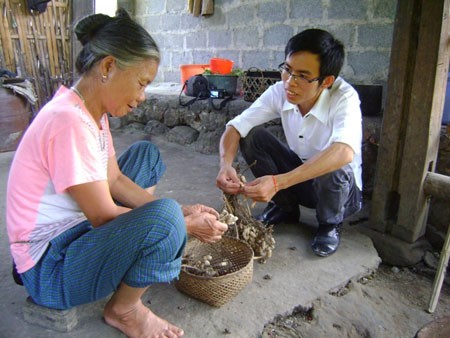(VOV) – The northern mountainous province of Ha Giang is blessed with beautiful landscapes and the cultural treasures of 22 ethnic minority groups. Since Dong Van Stone Plateau was recognized as a World Geological Park, Ha Giang has become an even more attractive destination for tourists. These advantages are enabling the province to develop community-based tourism and help its communes achieve national targets for new rural development. Today VOV reporter Huyen Trang will take you on a tour of Nam Dam hamlet in Quan Ba District to see how the locals are boosting tourism and new rural development.
 |
| Visitors find it interesting in doing daily activities with villagers. (Photo: Viet Tung – danviet.vn) |
The model of a community-based tourism village was first implemented in Nam Dam in 2006 when travel agents organized tours of several ethnic minority hamlets in Ha Giang and offered home-stays to the tourists. Realizing the advantages of this model, the provincial administration has helped to set up community-based tourism and cultural villages in Dong Van, Meo Vac, Xin Man and Hoang Su Phi districts. This has made use of the local potential in a way that improves people’s living conditions. Trieu Tai Vinh, Secretary of the provincial People’s Committee told VOV ‘Our goal is that each district will develop at least one cultural village in combination with tourism. But to achieve this target, we still face a lot of difficulties in investment sources, people’s knowledge, and scattered population. And district authorities haven’t been granted the authority to adjust the criteria. We have sent delegations abroad and to neighboring provinces to study their experiences, and are conducting a survey for this plan.’
Nam Dam hamlet still has many typical features of the Dao ethnic culture, including houses with thatched roofs and earthen walls. When tourists do a home-stay, they not get to eat traditional dishes, but also observe customs and rituals such as wedding and ceremonies to pray for bumper crops and offer new rice to ancestors. Visitors find it interesting to participate in gardening, harvesting, and cooking with the villagers. The model has generated jobs for hundreds of local residents. Ly Van Duyen, a Nam Dam citizen, says when his family was chosen for the program, he upgraded his house and equipped it with essential facilities to accommodate home-stay tourists. He elaborates further ‘Those who visit the village and stay overnight want art performances, so, of course, we satisfy their demand to show off our culture. We often organize ‘Le cap sac’, an initiation ritual marking a young man’s entry into manhood or a traditional wedding ceremony. Meals depend on each family but our specialty is smoked pork.’
Combining cultural tourism with new rural development in Nam Dam hamlet has changed Dao people’s ways of thinking and their awareness of preserving their cultural identity, beautifying their village, and improving the local roads and community house. Dang Thi Huong, Chairwoman of Quan Ba commune’s People’s Committee, says by 2015 the commune expects to welcome 2,000 visitors and become an attraction on the Dong Van Stone Plateau tour. She adds ‘Local villagers have strongly supported and cooperated in making Nam Dam a cultural tourism village. We have invested in building roads for which the province provides materials and the locals contribute their labor. We have mobilized local people to improve houses, move cattle pens away from homes, and involve the locals in building paved roads and a water supply to serve the hamlet.’
Huyen Trang